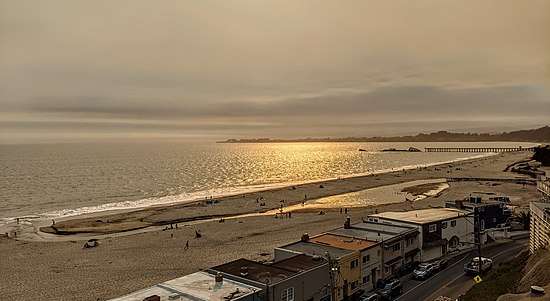Aptos Creek
Aptos Creek is a southward flowing 9.5 miles (15.3 km) creek that begins on Santa Rosalia Mountain on the southwestern slope of the Santa Cruz Mountains in Santa Cruz County, California and enters Monterey Bay, at Seacliff State Beach in Aptos, California.[3]
| Aptos Creek Arroyo de Outos[1] | |
|---|---|
 Aptos Creek at Spreckels Boulevard bridge in April, 2017 | |
| Location | |
| Country | United States |
| State | California |
| Region | Santa Cruz County |
| City | Aptos |
| Physical characteristics | |
| Source | |
| • location | Southwest flank of Santa Rosalia Mountain |
| • coordinates | 37°04′19″N 121°51′26″W[2] |
| • elevation | 2,502 ft (763 m)[3] |
| Mouth | Monterey Bay |
• coordinates | 36°58′11″N 121°54′22″W[3] |
• elevation | 7 ft (2.1 m)[2] |
| Basin features | |
| Tributaries | |
| • left | Mangels Gulch, Valencia Creek |
| • right | Bridge Creek |
History
The earliest record of "Outos" or "Aptos" is Arroyo de Outos in 1796, thought to be pronunciations of an Ohlone (Sp. Costanoan) village at the junction of Aptos and Valencia Creeks.[1] Rancho de Aptos was a sheep ranch of Mission Santa Cruz shown on documents dating to July 5, 1807.[4] Rancho Aptos was a 6,686-acre (27.06 km2) Mexican land grant in present-day Santa Cruz County, California, given in 1833 by Governor José Figueroa to Rafael Castro.[5]
Watershed and course
The Aptos Creek watershed drains 24.5 square miles (63 km2) beginning on the southwestern slope of 2,585 feet (788 m) tall Santa Rosalia Mountain[6] in the western Santa Cruz Mountains.[7] Over 60% of the watershed of the Aptos Creek mainstem lies within and is protected by The Forest of Nisene Marks State Park. The major tributaries are (from top to bottom) Bridge Creek, Mangels Gulch and then Valencia Creek (shortly after the latter receives its Trout Gulch tributary).

Ecology
The middle and upper watershed is in a second growth redwood (Sequoia sempervirens) forest that was clearcut over a forty-year period from 1883 to 1923. Coho salmon (Oncorhynchus kisutch) and steelhead trout (Oncorhynchus mykiss) in Central Coast streams are federally listed as endangered and threatened species, respectively.[7]
See also
- The Forest of Nisene Marks State Park
- Rivers of California
References
- Donald Thomas Clark (1986). Santa Cruz County Place Names: A Geographical Dictionary. Santa Cruz, California: Santa Cruz Historical Trust. ISBN 978-0940283015.
- "Aptos Creek". Geographic Names Information System. United States Geological Survey.
- U.S. Geological Survey. National Hydrography Dataset high-resolution flowline data. The National Map Archived 2012-04-05 at WebCite, accessed April 9, 2017
- Erwin Gustav Gudde (1960). California Place Names: The Origin and Etymology of Current Geographical Names. University of California Press. pp. 3–. GGKEY:403N5Z6QERG.
- Ogden Hoffman, 1862, Reports of Land Cases Determined in the United States District Court for the Northern District of California, Numa Hubert, San Francisco
- U.S. Geological Survey Geographic Names Information System: Santa Rosalia Mountain
- Maya T. Conrad; John Dvorsky (April 1, 2003). Aptos Creek Watershed Assessment and Enhancement Plan (Report). Coastal Watershed Council. Retrieved April 9, 2017.